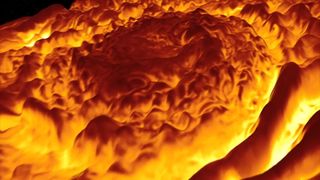
NASA scientists have solved the 39-year-old mystery of Jupiter's lightning storms.
When Voyager 1 flew past the planet in 1979, it collected data showing mysterious lightning-associated radio signals completely different to the signals produced by lightning on Earth.
In a paper published in the journal Nature, the scientists from NASA's Juno mission have discovered that Jovian lightning is inside-out compared to lightning on Earth.
While the revelation showed how Jupiter lightning is similar to Earth's, the new paper also notes that where these lightning bolts flash on each planet is actually quite different.
"Jupiter lightning distribution is inside-out relative to Earth," said Shannon Brown, a scientist at NASA's Jet Propulsion Laboratory and the lead author of the paper.
"There is a lot of activity near Jupiter's poles but none near the equator. You can ask anybody who lives in the tropics-this doesn't hold true for our planet," Mr Brown added.
This was probably due to the way that the gas giant was heated, the team believed - because on Earth, where we received most of our heat from the sun's radiation, the hottest place is the equator which receives the most of the sunshine.
This causes warm most air to rise most freely at the equator, powering huge lightning storms.
But for Jupiter, which orbits the Sun more than five times the distance that Earth does, and receives 25 times less sunlight, the atmosphere receives most of its heat from within the planet itself.

Although the Sun's rays heat up Jupiter's equator more than the poles - just as they do on Earth - the scientists believe that this actually stabilises Jupiter's atmosphere, preventing air warmed by the planet's interior from rising.
Because the poles do not have this upper-level warmth creating atmospheric stability, the warm gases from Jupiter's interior are able to rise and result in powerful lightning storms.
The research has posed an answer to a mystery which had been been puzzling scientists since the 1979 Voyager 1 flyby.
"No matter what planet you're on, lightning bolts act like radio transmitters - sending out radio waves when they flash across a sky," said NASA's Shannon Brown.
He said the previous analysis of Jupiter's atmosphere had been limited by the spacecrafts' equipment.
"Until Juno, all the lightning signals recorded by spacecraft were limited to either visual detections or from the kilohertz range of the radio spectrum, despite a search for signals in the megahertz range," Mr Brown explained.
"Many theories were offered up to explain it, but no one theory could ever get traction as the answer."
:: Cyclones look like lava flows in Juno flyover of Jupiter north pole
 1:10
1:10 Juno, which launched in 2011, has been orbiting Jupiter since July 2016.
Its highly sensitive scientific instruments include the Microwave Radiometer Instrument (MWR) which records radiation from deep inside the gas giant's atmosphere.
"In the data from our first eight flybys, Juno's MWR detected 377 lightning discharges," said Mr Brown.
"They were recorded in the megahertz as well as gigahertz range, which is what you can find with terrestrial lightning emissions.
More from Space
-
Revealed: Why days on Earth are getting longer
-
Astronauts prepare to leave International Space Station after 2,600 orbits
-
Astronaut Tim Peake reunited with Soyuz space capsule
-
'Space ant' fired laser at Earth, say astronomers
-
NASA astronauts undertake spacewalk to fix space station
-
NASA spacecraft could have flown through water past Jupiter moon
"We think the reason we are the only ones who can see it is because Juno is flying closer to the lighting than ever before, and we are searching at a radio frequency that passes easily through Jupiter's ionosphere."
Juno will make the 13th flyby out of 37 planned orbits over Jupiter's mysterous cloud tops on 16 July.
Original ArticleTechnology
0 comments:
Post a Comment